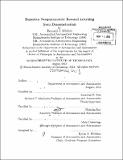Bayesian nonparametric reward learning from demonstration
Author(s)
Michini, Bernard (Bernard J.)
DownloadFull printable version (11.21Mb)
Other Contributors
Massachusetts Institute of Technology. Department of Aeronautics and Astronautics.
Advisor
Jonathan P. How.
Terms of use
Metadata
Show full item recordAbstract
Learning from demonstration provides an attractive solution to the problem of teaching autonomous systems how to perform complex tasks. Demonstration opens autonomy development to non-experts and is an intuitive means of communication for humans, who naturally use demonstration to teach others. This thesis focuses on a specific form of learning from demonstration, namely inverse reinforcement learning, whereby the reward of the demonstrator is inferred. Formally, inverse reinforcement learning (IRL) is the task of learning the reward function of a Markov Decision Process (MDP) given knowledge of the transition function and a set of observed demonstrations. While reward learning is a promising method of inferring a rich and transferable representation of the demonstrator's intents, current algorithms suffer from intractability and inefficiency in large, real-world domains. This thesis presents a reward learning framework that infers multiple reward functions from a single, unsegmented demonstration, provides several key approximations which enable scalability to large real-world domains, and generalizes to fully continuous demonstration domains without the need for discretization of the state space, all of which are not handled by previous methods. In the thesis, modifications are proposed to an existing Bayesian IRL algorithm to improve its efficiency and tractability in situations where the state space is large and the demonstrations span only a small portion of it. A modified algorithm is presented and simulation results show substantially faster convergence while maintaining the solution quality of the original method. Even with the proposed efficiency improvements, a key limitation of Bayesian IRL (and most current IRL methods) is the assumption that the demonstrator is maximizing a single reward function. This presents problems when dealing with unsegmented demonstrations containing multiple distinct tasks, common in robot learning from demonstration (e.g. in large tasks that may require multiple subtasks to complete). A key contribution of this thesis is the development of a method that learns multiple reward functions from a single demonstration. The proposed method, termed Bayesian nonparametric inverse reinforcement learning (BNIRL), uses a Bayesian nonparametric mixture model to automatically partition the data and find a set of simple reward functions corresponding to each partition. The simple rewards are interpreted intuitively as subgoals, which can be used to predict actions or analyze which states are important to the demonstrator. Simulation results demonstrate the ability of BNIRL to handle cyclic tasks that break existing algorithms due to the existence of multiple subgoal rewards in the demonstration. The BNIRL algorithm is easily parallelized, and several approximations to the demonstrator likelihood function are offered to further improve computational tractability in large domains. Since BNIRL is only applicable to discrete domains, the Bayesian nonparametric reward learning framework is extended to general continuous demonstration domains using Gaussian process reward representations. The resulting algorithm, termed Gaussian process subgoal reward learning (GPSRL), is the only learning from demonstration method that is able to learn multiple reward functions from unsegmented demonstration in general continuous domains. GPSRL does not require discretization of the continuous state space and focuses computation efficiently around the demonstration itself. Learned subgoal rewards are cast as Markov decision process options to enable execution of the learned behaviors by the robotic system and provide a principled basis for future learning and skill refinement. Experiments conducted in the MIT RAVEN indoor test facility demonstrate the ability of both BNIRL and GPSRL to learn challenging maneuvers from demonstration on a quadrotor helicopter and a remote-controlled car.
Description
Thesis: Ph. D., Massachusetts Institute of Technology, Department of Aeronautics and Astronautics, 2013. Cataloged from PDF version of thesis. Includes bibliographical references (pages 123-132).
Date issued
2013Department
Massachusetts Institute of Technology. Department of Aeronautics and AstronauticsPublisher
Massachusetts Institute of Technology
Keywords
Aeronautics and Astronautics.